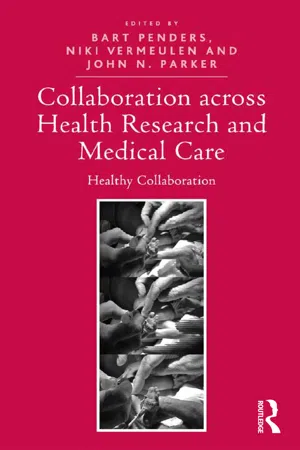Collaboration in Health
Historians have described the emergence of large biomedical complexes (Capshew and Rader, 1992; Creager, 1998; Neushul, 1993; Rasmussen, 2002; Seidel, 1992), which represent some of the first forms of complex, large-scale collaboration in health science and care. Collaborations between academic science and the biomedical industry can be traced back to the 1920s and 1930s when American pharmaceutical firms began investigating in research as a competitive strategy aiming to use science to inform therapeutic practice. These firms opened in-house laboratories and turned to university scientists as source of expertise: ‘In a typical collaboration, a firm would fund an academic researcher and stipulate that new processes and inventions be patented and assigned, or licensed on favourable terms, to the firm. Royalties to the university hosting the research would be part of the arrangement’ (Rasmussen, 2002: 120). In the context of World War II, alongside large-scale physics projects that produced the atom bomb, biomedical projects focussed on the development of penicillin and blood products. After the war the United States government became a leading patron of the expanding life sciences – funded by the National Science Foundation and the National Institutes of Health. Similar developments took place in other countries.
Turning our eye to the present, and painting with a broad brush, the study of collaboration in the health sector can for analytic purposes be separated, into three sets of studies. The first set, in line with studies of collaboration in other scientific fields, illuminates why, how, and in what ways health researchers join forces with each other. Building on De Solla Price’s (1965) seminal work on ‘big science’ and the growth of scientific inquiry, it assesses and measures collaboration through, for instance, quantitative analyses of the number of authors on a publication (Mattson et al., 2008). Such studies describe collaborative patterns in health and medical research, both internationally and regionally (e.g. Chinchilla-Rodríguez et al., 2012), often in connection to specific pathologies, such as stroke (e.g. Dirnagl et al., 2013). Simultaneously, in-depth qualitative empirical analyses of concrete cases explore the dynamics of health research collaboration, including its motivations, dynamics and consequences. Studies within this area also focus on laboratories, clinics, or larger, less tangible international collectives such as the Cochrane Collaboration (McKenzie et al., 2013) or clinical trials (Gennari et al., 2004; Petryna, 2009).
The second set of studies analyses collaboration between health care professionals, with clinics and hospitals as the main site for collaborative work. These studies research both policy and practice, and address themes such as the division of labour and the relative autonomy of diverse (semi-)professionals (e.g. Loxley, 1997; Hudson, 2002), leadership styles, language barriers, organisational boundaries, and the role of protocols and guidelines (e.g. Marshall et al., 1979; Ovretveit, 1990; McGrath, 1991; Leathard, 2003; Paradis et al., 2014). Medical sociology is a prominent source of this type of study (see e.g. Bird et al., 2010, esp. part iii), as are growing numbers of STS researchers studying medical practice and care (Strating et al., 2011; Van de Bovenkamp and Zuiderent-Jerak, 2013). Above all else, these studies highlight the social, political, and moral diversity within health care and their demonstrable effects on the work and infrastructures that shape it and the amount, relevance, and quality of care provided.
Finally, boundaries between research and care are fuzzy, as are boundaries between the institutions responsible for knowledge making and care-giving. A third set of studies spans the boundary between lab and clinic, that is, between research and care. Scholarship in this area deals with the interaction of professionals, disciplines, and sectors, and the translation of biomedical knowledge into a context of diagnosis, treatment or care. The concept of translational research – describing the movement of knowledge, data, and resources – can be traced back to the early 1990s, though it took until 2007 for the National Institutes of Health to propose a definition (Rubio et al., 2010). Still, Woolf (2008) commented immediately afterwards that ‘translational research means different things to different people’ (p. 211). He posited two ‘translational researches’, one dealing with ‘the transfer of new understandings of disease mechanisms gained in the laboratory into the development of new methods for diagnosis, therapy, and prevention and their first testing in humans’ and the other with ‘the translation of results from clinical studies into everyday clinical practice and health decision making’ (ibid.). Consequently, both translational ‘researches’ require different tools, skills, and resources and happen in different places.
This volume brings together studies of collaborative practice spanning these three sets of literature by investigating collaborations in and across research and care while paying special attention to intersections between these different bodies of literature since collaborations often cannot be confined to one domain. More specifically, within the health sector a rapidly changing landscape presents professionals operating within it with complexities and uncertainties requiring the combination of multiple social roles and collaborations with diverse sets of actors. Consider, for instance, the growing scale of health collaboration, in which large international consortia devoted to medical innovation are established, clinical trials are conducted simultaneously in various countries, and treatment guidelines are pushed globally. These processes are associated with increasing pressure to standardise through protocols or guidelines and increasing adoption of evidence-based medicine, again demanding coordination and ...
